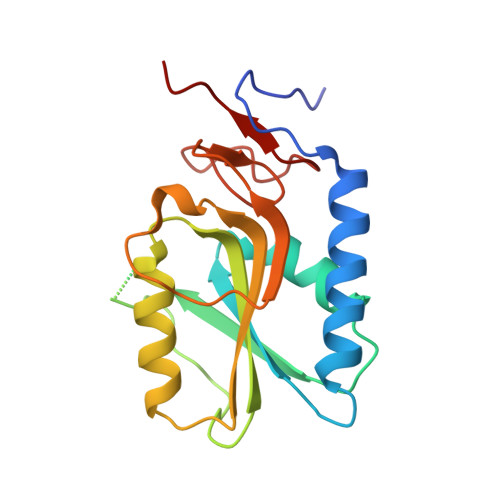Structures of hypoxanthine-guanine phosphoribosyltransferase (TTHA0220) from Thermus thermophilus HB8.
Kanagawa, M., Baba, S., Ebihara, A., Shinkai, A., Hirotsu, K., Mega, R., Kim, K., Kuramitsu, S., Sampei, G., Kawai, G.(2010) Acta Crystallogr Sect F Struct Biol Cryst Commun 66: 893-898
- PubMed: 20693661
- DOI: https://doi.org/10.1107/S1744309110023079
- Primary Citation of Related Structures:
3ACB, 3ACC, 3ACD - PubMed Abstract:
Hypoxanthine-guanine phosphoribosyltransferase (HGPRTase), which is a key enzyme in the purine-salvage pathway, catalyzes the synthesis of IMP or GMP from alpha-D-phosphoribosyl-1-pyrophosphate and hypoxanthine or guanine, respectively. Structures of HGPRTase from Thermus thermophilus HB8 in the unliganded form, in complex with IMP and in complex with GMP have been determined at 2.1, 1.9 and 2.2 A resolution, respectively. The overall fold of the IMP complex was similar to that of the unliganded form, but the main-chain and side-chain atoms of the active site moved to accommodate IMP. The overall folds of the IMP and GMP complexes were almost identical to each other. Structural comparison of the T. thermophilus HB8 enzyme with 6-oxopurine PRTases for which structures have been determined showed that these enzymes can be tentatively divided into groups I and II and that the T. thermophilus HB8 enzyme belongs to group I. The group II enzymes are characterized by an N-terminal extension with additional secondary elements and a long loop connecting the second alpha-helix and beta-strand compared with the group I enzymes.
Organizational Affiliation:
RIKEN SPring-8 Center, Harima Institute, 1-1-1 Kouto, Sayo, Hyogo 679-5148, Japan.
















